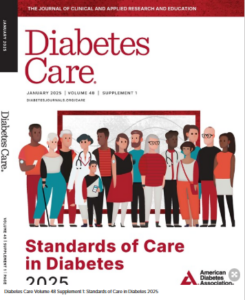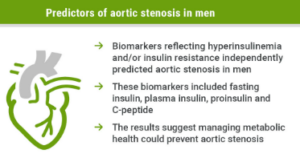In this week’s issue of The Savvy Diabetic:
-
ADA DiabetesStandards of Care 2025
-
Cleerly Coronary Computed Tomography Angiography (CCTA)
-
Video: Implantable 365-Day CGM Procedure
-
Biomarkers of Insulin Resistance & Aortic Stenosis
-
Medtronic CGM Data on 3rd-Party Devices
-
Effort to Force Insurers & PBMs to Sell Pharmacy Businesses
-
Riva Greenberg on Medicare Open Enrollment Stress
Diabetes Technology: Standards of Care in Diabetes—2025 by the American Diabetes Association Professional Practice Committee, published in DiabetesJournals.org, 9 December 2024.
 The American Diabetes Association (ADA) “Standards of Care in Diabetes” includes the ADA’s current clinical practice recommendations and is intended to provide the components of diabetes care, general treatment goals and guidelines, and tools to evaluate quality of care. Members of the ADA Professional Practice Committee, an interprofessional expert committee, are responsible for updating the Standards of Care annually, or more frequently as warranted.
The American Diabetes Association (ADA) “Standards of Care in Diabetes” includes the ADA’s current clinical practice recommendations and is intended to provide the components of diabetes care, general treatment goals and guidelines, and tools to evaluate quality of care. Members of the ADA Professional Practice Committee, an interprofessional expert committee, are responsible for updating the Standards of Care annually, or more frequently as warranted.
The Standards of Care in Diabetes—2025 (Standards of Care) is the gold standard in evidence-based guidelines for diagnosing and managing diabetes and prediabetes. Based on the latest scientific research and clinical trials, the Standards of Care includes strategies for diagnosing and treating diabetes in both youth and adults, methods to prevent or delay type 2 diabetes and its associated comorbidities like obesity, and care recommendations to enhance health outcomes.
“The latest ADA guidelines combine comprehensive, evidence-based recommendations for diabetes care with actionable guidance to enable health care professionals provide the best care possible for those living with diabetes,” said Nuha El Sayed, MD, MMSc, the ADA’s senior vice president of health care improvement.
Read more: Diabetes Technology: Standards of Care in Diabetes—2025
Cleerly raises $106M to fund AI-driven heart disease tool by Nick Paul Taylor for MedTechDive.com, 6 December 2024.
 Coronary computed tomography angiography (CCTA) enables physicians to assess patients’ risk of coronary artery disease noninvasively. The imaging technique, recommended in clinical guidelines, facilitates the evaluation of atherosclerosis to determine the likelihood of disease progression and cardiovascular events. However, whole-heart quantitative CCTA analysis is a skilled and time-intensive task.
Coronary computed tomography angiography (CCTA) enables physicians to assess patients’ risk of coronary artery disease noninvasively. The imaging technique, recommended in clinical guidelines, facilitates the evaluation of atherosclerosis to determine the likelihood of disease progression and cardiovascular events. However, whole-heart quantitative CCTA analysis is a skilled and time-intensive task.
Cleerly has developed a tool to automate CCTA analysis using 10 million images of 40,000 patients. The company has validated the technology in multi-center trials, showing its equivalence to other techniques and its ability to reduce the need for invasive testing. One study that used the technology as a gatekeeper to detect vessel narrowing tracked an 86% reduction in invasive coronary angiograms.
Cleerly CEO James Min said in a statement that the use of the funding for commercialization “is especially germane” following the Medicare coverage and a CPT category I code for advanced plaque analysis.
Read more: Cleerly raises $106M to fund AI-driven heart disease tool
Implantable 365 Day CGM Sensor Procedure with Dr. Steve Edelman for TCOYD.org, 11 December 2024.
 Join Dr. Steve Edelman, Dr. Jeremy Pettus, and Dr. David Ahn as they demonstrate the simple insertion procedure for the Eversense 365 Continuous Glucose Monitoring system. This comprehensive guide is designed for healthcare professionals interested in learning about this year-long CGM solution.
Join Dr. Steve Edelman, Dr. Jeremy Pettus, and Dr. David Ahn as they demonstrate the simple insertion procedure for the Eversense 365 Continuous Glucose Monitoring system. This comprehensive guide is designed for healthcare professionals interested in learning about this year-long CGM solution.
Important Notes for Healthcare Providers:
-
-
- No mandatory insertion certification required – can refer to certified inserters
- Procedure takes only minutes – suitable for lunch break appointments
- Saves patients 26-36 sensor applications per year
- Reduces issues with skin irritation and adhesive reactions
- Minimizes compression lows and false alerts
-
That’s pretty interesting, right? As we always say, so many solutions are available for your patients. Let’s continue educating, supporting, and empowering our patients for better care!
Biomarkers of Insulin Resistance Are Risk Factors for Aortic Stenosis by Elana Gotkine for HealthDay.com, 9 December 2024.
 Biomarkers of insulin resistance are risk factors for aortic stenosis (AS), according to a study published online Nov. 27 in the Annals of Medicine. Maija Sohlman, from the University of Eastern Finland in Kuopio, and colleagues examined biomarkers and the risk for AS in a prospective population-based study.
Biomarkers of insulin resistance are risk factors for aortic stenosis (AS), according to a study published online Nov. 27 in the Annals of Medicine. Maija Sohlman, from the University of Eastern Finland in Kuopio, and colleagues examined biomarkers and the risk for AS in a prospective population-based study.
“As insulin resistance and hyperinsulinemia appear to be important risk factors for AS, measures improving insulin sensitivity, such as weight control and exercise, might be effective in the prevention of aortic stenosis,” the authors write.
Read more: Biomarkers of Insulin Resistance Are Risk Factors for Aortic Stenosis
How to Get Medtronic CGM Readings on 3rd Party Devices by Justin Eastzer for Diabetech (TikTok | Insta | Youtube | Podcast | Blog), 13 December 2024.
 Justin Eastzer walks you through how to get Medtronic CGM readings (Simplera and Guardian sensors) onto third-party devices using Nightscout. With a Nightscout link, you can get readings on devices like Garmin, Fitbit, SugarPixel, and beyond!
Justin Eastzer walks you through how to get Medtronic CGM readings (Simplera and Guardian sensors) onto third-party devices using Nightscout. With a Nightscout link, you can get readings on devices like Garmin, Fitbit, SugarPixel, and beyond!
New bipartisan legislation would force insurers, PBMs to sell pharmacy businesses by Rebecca Pifer for HealthCareDive.com, 11 December 2024.
 A bipartisan group of legislators is seeking to break up pharmacy benefit managers by forcing them to sell pharmacy businesses, in what experts described as Congress’ most radical attempt to reform the controversial drug middlemen to date. Sens. Elizabeth Warren, D-Mass., and Josh Hawley, R-Mo., introduced a bill in the Senate that would require healthcare companies that own health insurers or PBMs to sell pharmacy assets within three years. A companion bill was also introduced in the House.
A bipartisan group of legislators is seeking to break up pharmacy benefit managers by forcing them to sell pharmacy businesses, in what experts described as Congress’ most radical attempt to reform the controversial drug middlemen to date. Sens. Elizabeth Warren, D-Mass., and Josh Hawley, R-Mo., introduced a bill in the Senate that would require healthcare companies that own health insurers or PBMs to sell pharmacy assets within three years. A companion bill was also introduced in the House.
The legislation, if passed, would be a massive shakeup for the U.S. pharmacy supply chain, cutting off revenue and market power for PBM giants and the conglomerates that own them. Forcing PBMs to offload owned pharmacies would also directly benefit independent pharmacies, which accuse PBMs of paying them less than in-house businesses for dispensing medication and directing patients away from their doors.
“It’s very unclear whether the fact that PBMs own pharmacies is good or bad for consumers on balance. Given that, it’s unclear if forcing them to divest their pharmacies would be good or bad on balance,” said Matt Fiedler, a senior fellow at the USC-Brookings Schaeffer Initiative for Health Policy.
However, it’s unlikely the legislation — which continues Congress’ recent habit of zeroing in on PBMs, not drug manufacturers, as the main culprit behind skyrocketing drug prices — will pass before the end of the year.
Read more: New bipartisan legislation would force insurers, PBMs to sell pharmacy businesses
Thankful, and exhausted from choosing next year’s healthcare insurance by Riva Greenberg for DiabetesStories.com, 28 November 2024.
From my dear friend, Riva Greenberg, at the end of Medicare’s open enrollment period: With all the changes to healthcare insurance policies I don’t know anyone who isn’t struggling to figure out what their best choice is next year. At least those of us who don’t have an employer who pays our healthcare. I can’t offer you much counsel other than googling the topic to death and seeing if a Medical health broker can help inform and guide you if you’re over 65.
 I’ve been doing both, as well as consulting with my friends, all in similar confusion and disgust. Thus the exhaustion. Yet thought this little illustration was worth sharing if it brings a smile. Enjoy the day and we’ll keep keepin’ on through it all.
I’ve been doing both, as well as consulting with my friends, all in similar confusion and disgust. Thus the exhaustion. Yet thought this little illustration was worth sharing if it brings a smile. Enjoy the day and we’ll keep keepin’ on through it all.
Read more: Riva Greenberg’s Diabetes Stories


Oh, how I would love to be a patient on the ADA Standards of Care committee. I have done it with arthritis, and I love the process. I do not know anyone at the ADA who might suggest I be included. I love the ACR process. It took two 8-hour days, and we looked at everything. If I ever had the chance to do this diabetes, I would sign up immediately.
The 360-day CGM is fantastic – provided it works. Again, sign me up when it works with Omnipod.
I am sorry Riva had difficulty with the Medicare sign-up process this year. For diabetes, mine is pretty smooth. Now, arthritis was a concern, but in the end, I chose to stay where I was. It is all about the advisor you get. Make them do the work.
LOL, maybe because I use 15 each day, plus the typical associated diabetes stuff; it is more about the bigger issue.
Now, want to talk about PBM’s? I will not leave my complainant letter; suffice it to say I think PBM is needed. why we don’t have it, I will never understand. If you ever hear a committee needs a patient who understands PBM’s, please add my name. I have been an employer using PBM’s and a consumer, I understand the reason for PBM’s and the effect of PBm’s on consumers.